Demand response (DR) exists to provide value to electric utilities and their customers. In any of its manifestations, the effect of DR is to temporarily reduce end-user demand on utility supply resources.
Demand response (DR) currently exists for these purposes:
- to limit peak demand during temporary periods of peak heating or cooling
- to offset supply disruptions, transmission outages, or other capacity constraints
- to adapt energy systems to the intermittency of supply from solar and wind energy
DR experienced strong growth over the past 10 years. DR will grow strongly in this new decade as well, although the factors leading to growth must change. The obstacles that stand in the way of continuing with the established growth phase relate to ability to scale, regulations, and cost efficiency.
DR in the 2010s
Demand response in the 2010s was almost exclusively managed from the supply side. Strong growth in DR was facilitated mainly by Curtailment Service Providers (CSPs) that serve the power capacity markets. Growth was also made possible by advancements in controls technology, energy storage such as customer-sited batteries, and various government and utility incentives. The CSPs serve the capacity markets. Capacity markets ensure that load serving entities (LSEs, e.g. electricity transmission and distribution) commit to providing adequate supply, particularly peak supply, to balance demand throughout the year. As part of the capacity market, DR functions as if it were an LSE, although technically it is not.
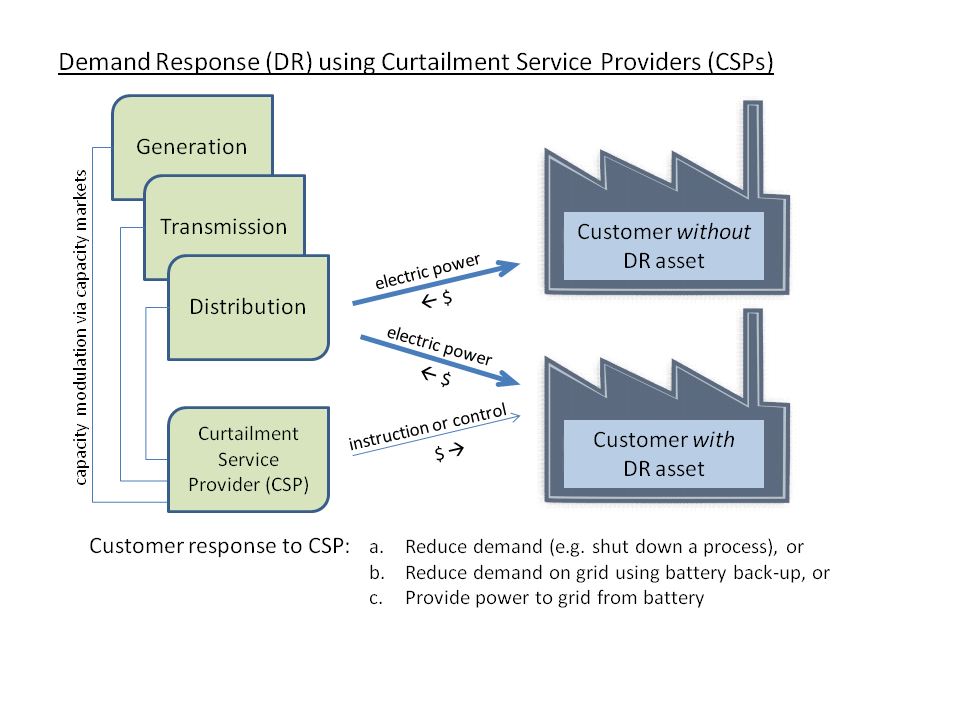
On the demand side, the most typical DR placement was, and still is with industrial/manufacturing consumers of electrical power, which represent 50% of the market or more. By its very nature, industry is well suited for DR. Industry uses electricity in its processes, and when those processes aren’t needed 100% of the time, it’s often possible to shift power consuming processes to different times of day, or even different days altogether. Large batteries or other forms of back-up power can also be used if the savings from DR are high enough to cover the costs.
Limitations of the Status Quo
As noted previously, DR capability must be available to curtail load year round in order to be accepted in the capacity market. This is a regulatory requirement. This requirement for year round curtailment capability is only possible when the DR capability is a subset of Capacity Performance (CP). Today, 95% of DR revenue comes from CP. However, being reliant on capacity markets is problematic.
Scale Issues
According to PJM, power capacity accounts for only about 15% of the overall spend for power. If the power market (generation, transmission, and distribution) is a whole pie, the power capacity market is one slice of that pie, and DR is about 5% of that slice of pie, or just one bite of the whole pie. In other words, despite its growth, DR is still a relatively small part of the power market. If it is going to continue to scale, it will need to move beyond the capacity market.
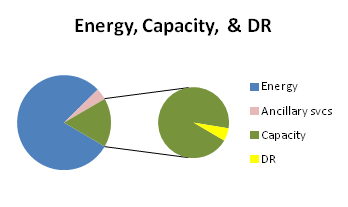
Economic Efficiency
Another issue with DR being relegated to the capacity market is that the capacity market is not a market optimized for economic efficiency. The main objective of CP is to ensure sufficient capacity is available to meet demand at all times. For DR, this leads to a side effect that’s known as the double payment issue. Currently, when owners of the DR asset reduce demand, they not only reduce energy costs, but they also get paid to do so. In other words, the DR asset owner gets rewarded twice for the same action. This double payment effect can lead to gaming of the system for profit. Alternatively, if sought changes in demand were resulting from demand pricing alone, then the double payment issue would be avoided. As a result, economic efficiency would rise.
Regulatory Considerations
The FERC has regulatory oversight over the RTOs. The regional transmission organizations (e.g. PJM, ISO-NE) administer forward capacity markets. In Q4 of 2019, FERC weighed in on PJM and the capacity markets serving it. FERC placed burdens on new DR installations which effectively render them uneconomic (see 169 FERC ¶ 61,239).
Whether the new FERC regulations adhere long term remains an open question. Either way, these regulations demonstrate the uncertainty that is inherent in government regulatory authority. The best way to avoid regulatory involvement is to focus on markets that run themselves without the need for government involvement between parties.
DR in the 2020s and beyond
The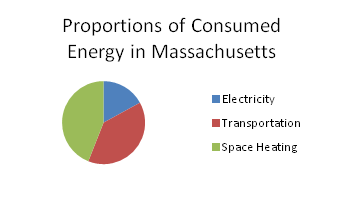 value of DR will continue to grow. The electricity market is a relatively small part of the overall energy mix, but it’s growing strongly. In Massachusetts for example, electricity makes up 17% of consumed energy with the other 83% coming from transport 44%, and thermal 39%. The overall trend is toward electrification of both transportation and space heating, so that the present 17% share of energy is going to move up substantially and relatively quickly. Demand Response has the capability to help facilitate this transition.
value of DR will continue to grow. The electricity market is a relatively small part of the overall energy mix, but it’s growing strongly. In Massachusetts for example, electricity makes up 17% of consumed energy with the other 83% coming from transport 44%, and thermal 39%. The overall trend is toward electrification of both transportation and space heating, so that the present 17% share of energy is going to move up substantially and relatively quickly. Demand Response has the capability to help facilitate this transition.
New Opportunities for Growth
Because of these strong trends, opportunities for growth in DR are best in new market segments, using different strategies and technologies. Take for example the fast growing trend in transportation powered by electricity. Demand for electrically-powered transportation, particularly cars and trucks, is expected to grow strongly for decades to come. The growing demand for electrical power in transportation will place transportation alongside the other large user segments of electrical power: industrial, commercial and housing.
The housing sector, specifically in heating, cooling and domestic hot water (DHW), is another growing area for electricity consumption. The growth is coming from more heat pumps being installed. Technologically speaking, heat pumps have progressed significantly over the past decade. Because they perform very efficiently, and they have the ability to be used for both heating and cooling, they are already growing strongly in supplemental retrofit situations. They are also being used more and more in new construction as well, and may well completely displace oil and gas within a couple of decades.
The market for electricity is dependent on its infrastructure. As the trend toward electrification gains momentum, there will be more demands made on the grid. It’s hard and expensive to build new transmission assets in built-up areas. Both efficiency and DR will make important contributions to meeting these new demands.
Moving Decision-making from Supply Side to Demand Side
Because demands on the electrical grid are becoming greater, especially during peak events, growth in DR is desperately needed. Some of the growth can be supported by the capacity markets. But as capacity markets are small relative to the expected increase in demand, there is a much larger opportunity for growth outside of the capacity markets.
Growth can come from any other part of the supply chain, such as generation, and LSEs (transmission and distribution), wherever there is some value either in lowering peak demand or in shifting demand away from peak hours. Value can be perceived by one or any combination of participants in the supply chain. The value from reducing peak demand can be temporary, such as just a few hours. And it can be either one-off or recurring, such as, for example any day where temperatures exceed 85°F, or fall below 20°F.
Achieving Economic Efficiency with DR
In the coming decade, the financial catalysts for growth need to change. The opportunity for growth will shift from the capacity market to the energy market; the energy market share of the pie is much bigger, and there’s more latent value to be realized. Suppliers can affect demand by varying the price. There’s an opportunity to improve economic efficiency by letting suppliers use market forces to determine peak demand pricing on a day ahead basis.
DR and Retail Energy Markets
Demand Side Management (DSM) offers potential for shifting demand away from peaks. With pricing signals, demand can be proactively reduced or shifted, depending on the goals of the entity making the price.
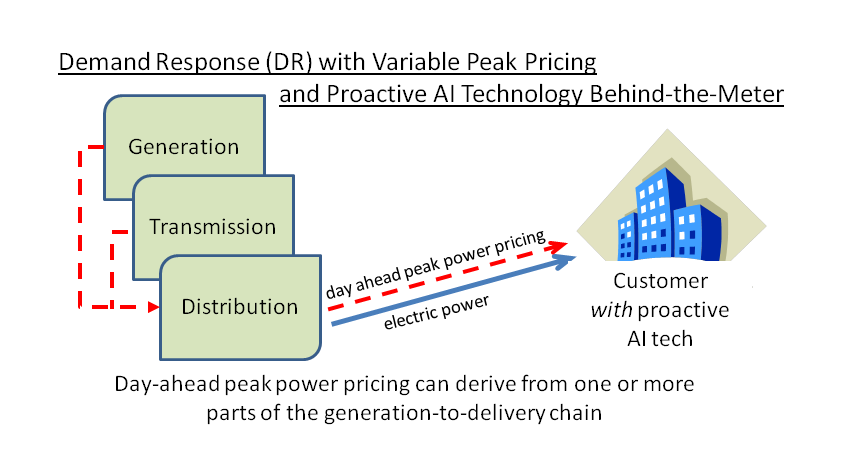
Keys to successful variable demand pricing includes interval metering, day ahead pricing, and technology that uses price signals to modulate demand. Also important is finding how elastic the demand is for classes of energy consumers. As day ahead demand pricing will be an important component of growth in DR in this decade, and because there is a learning curve to using it, it’s important to start planning and using it as soon as possible.
Be sure to follow if you’re interested in this subject as I will be following up with more on the future of DR growth for utilities in the weeks to come.
Back to top of post
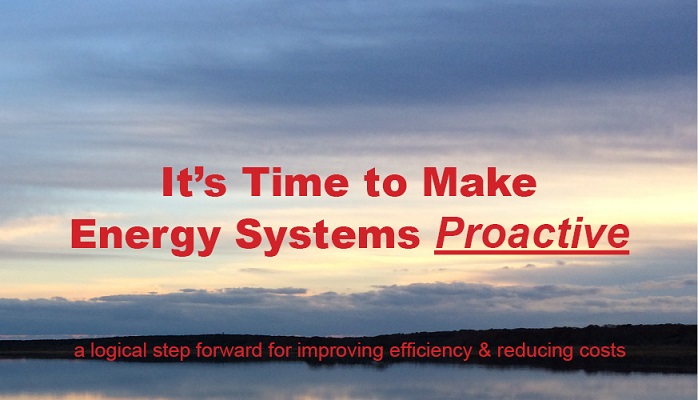
Making energy systems proactive is a logical step forward in improving building energy efficiency
Proactive building energy systems can increase energy efficiency, improve comfort, lower energy costs, reduce peak energy loads, and increase property values.
What is a proactive building energy system?
A proactive building energy system uses forward-looking input factors such as a building’s thermal momentum, near-term weather forecasts*, and demand costs to help determine system outputs. Artificial intelligence (AI) software uses strings of data inputs and self-learning to calculate outputs and optimize system performance.
A proactive energy system can be an add-on part of a very basic system, or it can can be integrated with a complex building management system (BMS) using open protocols or something else.
Contrast with today’s reactive energy systems
Nearly all building energy systems in North America today are reactive. A typical example would be a temperature set-point being reached which triggers a relay that starts or stops one or more devices (e.g. pump, boiler, chiller). There may be a variable component to the output, such as a distribution temperature selected from a heating curve. Commonly, a PID control determines the targeted output . The production and distribution technologies themselves (e.g. condensing boilers, variable speed heat pumps, low-temp hydronic distribution, etc.) may be high efficiency in a stand-alone sense. Nevertheless, they are limited by the narrow range of input data that are available to them.
Key differences between reactive and proactive system control
When external factors are changing quickly as is typical with nearly constant changes in weather factors (such as temperature), or when demand rates kick in, the reactive system loses its ability to optimize energy inputs.
Proactive energy systems on the other hand, use a range of data that includes forward-looking data that feed dynamic algorithms. With proactive systems, there can also be some automated learning involved as improvements build on past improvements. This is where AI can play an important role. The AI is used to determine thermal inertia and thermal momentum, both of which are important for maintaining targets without over or under performance. Reactive controls don’t have this ability.
Fortunately, there are more similarities than differences. Proactive systems and reactive systems use the same building assets. So from an upgrade perspective, it can be very easy to make the change.
Examples of proactivity in our lives
Although you may not have thought about it in this way, being proactive is a natural part of our everyday lives. There are countless examples of being proactive that illustrate this point.
Here are a just a few examples from one thing many of us do every day: drive a car. Imagine you’re behind the wheel of your car and you’re driving down the  road. You see a sign that says “Stop Ahead”. This is an opportunity to be proactive. You can take your foot off the accelerator and let the momentum of the car carry you forward to the stop line. That’s proactive and saves a little bit of energy. Now imagine you’re on a highway and you see a sign that says “Exit Right 1 Mile”. If that’s your exit, you can look for a good opportunity to move over to the right lane. That’s also being proactive. A third example is when you drive with your high beams on at night, you’re gaining more “visual data”; you can be more proactive in dealing with upcoming road hazards.
road. You see a sign that says “Stop Ahead”. This is an opportunity to be proactive. You can take your foot off the accelerator and let the momentum of the car carry you forward to the stop line. That’s proactive and saves a little bit of energy. Now imagine you’re on a highway and you see a sign that says “Exit Right 1 Mile”. If that’s your exit, you can look for a good opportunity to move over to the right lane. That’s also being proactive. A third example is when you drive with your high beams on at night, you’re gaining more “visual data”; you can be more proactive in dealing with upcoming road hazards.
Of course, being proactive doesn’t necessarily have to lead to greater efficiency. Proactive measures in energy are worth doing if they help achieve an objective like lower energy use, lower demand charges, or higher comfort.
Thermal momentum quantified and used proactively
Being proactive helps increase efficiency in cases where momentum (including thermal momentum) and inertia are significant factors. Thermal momentum is identified and used by AI for proactive control.
As momentum is the product of mass and velocity, higher mass leads to higher momentum. As an example of this concept, heavy trucks benefit more from that “Stop Ahead” sign than does a car, and the car benefits more than a bicycle. A pedestrian may not benefit at all. So the greater the mass, the greater the momentum, and this is true in buildings as well. Proactive AI control can account for momentum and inertia, and use it to improve overall efficiency.
A multifamily building is full of walls, floors, ceilings, carpeting, furniture, and plumbing. Therefore it is relatively dense. An empty airplane hangar, a big space filled with nothing but air, is not dense. As a result, changes in thermal energy can occur much more quickly in the hangar (assuming the building size, energy systems, and building envelopes are equivalent). Because the multifamily building is denser, it takes longer to heat up, and is slower to cool down. All that mass inside the building is a heat sink. That mass is absorbing and radiating back out thermal energy constantly. If a heating system reacts to a set point being reached, and stops pumping heat into the building, that building mass will continue to radiate heat back into the living space. If the outdoor temperature rises or sunlight streams in, the interior of the building can become overheated.
Consistent building temperatures with proactive control
Another thing we can say about the multifamily building is that steady temperature is important to the people that live there. Zeroing in on a set point temperature is a challenge that is easier with AI and proactive control. Multifamily building owners know that the alternative to consistent indoor temperatures is either complaints, open windows in winter, or both. It also can lead to higher energy costs, increased tenant turnover, and lower rents.
Lowering demand peaks in district energy with proactive control
In cases where there is an energy demand rate**, it’s possible for a proactive energy system to optimize operation to pre-load heating or cooling, and to hold back from the high demand peaks that drive demand charges. As noted earlier, this is a valuable tool where building mass can be used to advantage. This is most common for buildings connected to district energy networks, but is evident in other energy scenarios as well.
Other applications for proactive energy control
Besides thermal energy, as described above, there are other forms of energy consumption that can, and sometimes do benefit from proactive control.
- Natural gas consumption
- Electrical power (demand response)
- District energy (heating or cooling)
- Chilled water /sensible cooling
Back to top of post
*useful weather data may include the timing of upcoming temperature, sunlight, wind, and precipitation.
**energy demand rate – charged by some district energy utilities and electric utilities. Demand charges may be tiered, and can vary by time of day and time of year. In some cases demand rates change daily, with a day or less of advance notice. Demand charges help utilities pay for the higher marginal cost of supplemental energy sources, or the cost of infrastructure needed to meet peak demand.
© 2019
Optimizing district energy use from the building-side (i.e. point-of-use) has many benefits, including lower costs and higher building value.
District energy is the go-to energy source for many buildings in urban areas. For a new building, connecting with a district energy network can mean lower up front costs, as investing in boilers or furnaces, air conditioning units, chimneys, and large boiler rooms are rendered unnecessary.
District energy-connected buildings benefit from no energy equipment maintenance. The district energy provider of course maintains a large plant, and those maintenance costs that it incurs benefit from it’s economies of scale. Those costs are passed on to the customer in the price of energy.
District Energy Rate Structures
District energy providers can charge for the energy they provide in a variety of ways. First, they can charge differently depending on the type of customer, such as multifamily, industrial, or office building.
Second, there may be different rate structures depending on past energy use. Users of energy can be shifted by the provider from one rate group or another based on past consumption levels. Third, and adding some complexity, each one of those rate groups can consist of multiple tiers of energy use, where the first “x” amount of energy use is charged at one level, the next batch of energy used above that would have another rate, the third quantity of energy above that another rate, and so on.
A fourth component of district energy costs is time-of-use rate. Some district energy providers charge higher rates, for example, between 8am and noon on weekdays, at certain times of year. These rates are usually posted and published well in advance, and they usually don’t change except for seasonally.
A fifth component is the demand rate. District heating companies can charge for each unit of energy, such as the peak amount of steam, or BTUs passing through the meter in a short period of time, like 15 minutes, over the course of a billing period. Providers can define their demand rates differently, so the details matter.
Day-Ahead Rates
Another rate type that is not so common in North America at this time is the day-ahead rate. It’s possible for district energy providers to anticipate demand ahead of time. With this knowledge, they can post a rate or rates for the following day. For example, if the energy provider expects heavy demand from 8am to 10am the following day, they can notify customers of a higher rate during that time slot. Customers with appropriate technology can then respond by shifting more of their energy consumption to before and after that time slot if the difference in energy costs is significant.
Technology Solutions
Technology that uses artificial intelligence (AI) has been developed that makes it possible to reduce all of these charges, by using the district energy more smartly. A successful example of this is our Finnish technology partner Leanheat.
Leanheat’s technology has been successfully deployed in district heating-connected buildings that collectively house tens of thousands of apartment units. Those apartment units have their heating and cooling costs bundled into the rent by the building owners. The Leanheat technology saves the building owners from 10-20% over previous energy consumption, without any sacrifice in comfort.
Contact CIMI Energy for information about the Leanheat district energy optimizing solution.
Outdoor reset technology, which uses a single outdoor temperature sensor to determine boiler temperatures, is being eclipsed by innovative control technologies that utilize multiple factors plus artificial intelligence (AI) to increase efficiency.
As an efficiency solution, outdoor reset is a step above older technologies that didn’t use any external factors for setting the boiler temperature. However, with the most cutting edge technologies of today, there are many additional factors that can be taken into account, and which improve efficiency even more.
Outdoor Reset Technology
Outdoor reset is a technology that correlates boiler settings with the outdoor temperature in one spot outside the building. The purpose of this match-up is to increase efficiency by lowering systemic losses of energy that naturally occur from the production and distribution of thermal energy.
Here’s how outdoor reset works. Heating curves are shown in the image below. One of the curves is chosen manually by an installer or commissioning agent. The colder the outside temperature, the hotter the water that’s produced (or the longer the system runs, in the case of steam systems). The heating curve slope is chosen manually (top image) and the level of the slope is also chosen (2nd image).
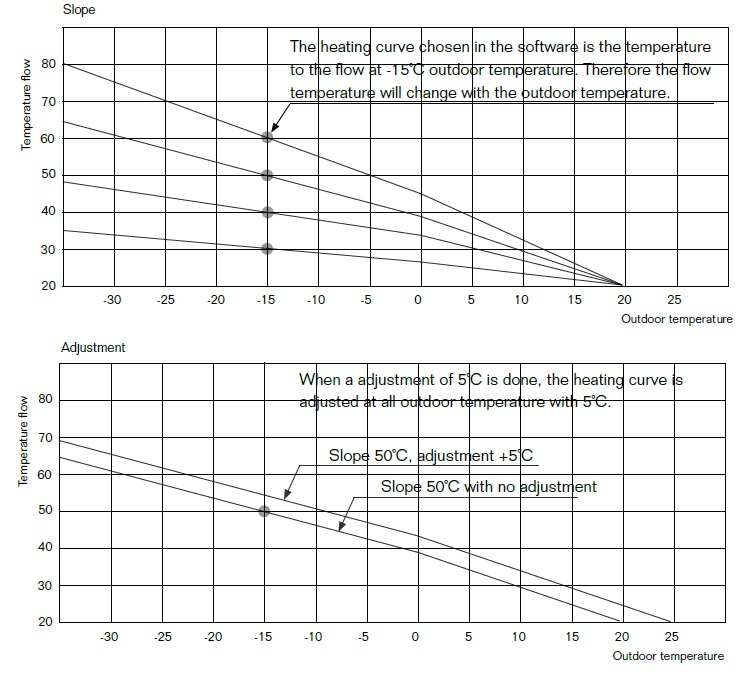
Choosing an Outdoor Reset Curve
Often there are more than a dozen curves to choose from. There is inherently some uncertainty in choosing a curve. One could argue that choosing a curve is part art and part science. The main objective is to find a curve that will work for the building, and that leaves some room for error. Finding that a curve is not steep enough, for example, is only going to be discovered when it’s really cold out. This is not a good result. Yet by choosing a curve that’s steeper than necessary, some system efficiency is sacrificed.
Once the system is set up, the chosen curve is usually not changed more than once or twice, if at all, so there’s not much in the way of “fine-tuning”. Curve adjustments are only made after the fact, based on tenant complaints. If the curve is too steep, tenants will not complain, yet efficiency is sacrificed.
[Note that steam systems use outdoor reset, but don’t work exactly like this. Read about steam systems here:
A Modern Innovation for Improving the Efficiency of Steam Heating Systems]
Upgrading from Outdoor Reset to Leanheat AI
Among the factors that can be used to improve system efficiency is a group of building-specific factors such as how a building reacts to sun (e.g. amount of sunshine, time of day and time-of-year), wind (speed and direction), and “thermal inertia”, how a building responds to the heating system. Other important factors that are accounted for are individual unit temperatures, particularly those units farthest from the heat source. What’s needed to account for all these factors is energy intelligence software using algorithms that learn and adapt.
Leanheat AI actually takes into account all these extra factors using local weather forecasts, plus in-unit temperatures and humidity levels that are gathered by strategically placed sensors through cellular IoT technology. Without human intervention, a dynamic heating curve unique to the building is created. Boiler temperatures are controlled better, so there’s none of the typical large buffer that’s always been a necessary part of outdoor reset-controlled systems. As a result, the heating system runs more efficiently. In Finland, where Leanheat was first introduced, efficiency improvements of 10-20% have been realized.
An added benefit has been lower technical maintenance costs, such as from identifying and correcting housing units where climate control is problematic.
Back to top of post
It’s now possible to lower energy costs by applying bundled technologies that find and use each building’s “Unique Energy Fingerprint” (UEF).  Our partner Leanheat has created energy intelligence software that bundles artificial intelligence (AI) with the Internet of Things (IoT) to determine each building’s UEF. The technologies integrate seamlessly with existing building assets. Building energy use is reduced through improvements in system efficiency.
Our partner Leanheat has created energy intelligence software that bundles artificial intelligence (AI) with the Internet of Things (IoT) to determine each building’s UEF. The technologies integrate seamlessly with existing building assets. Building energy use is reduced through improvements in system efficiency.
Before this technology became available, this level of efficiency improvement was not achievable in a cost-effective way using current assets. Improvements that have been made have been limited by the available technology. The potential for improved control technology has expanded greatly. Leanheat has been able to focus on realizing that potential for the purpose of lowering building energy use and costs.
There are two major differences between using a building’s UEF and today’s common control optimizer, outdoor reset (OR). First is that the UEF is based on more variables (as opposed to just one or two with OR), giving a more precise picture of the heating and cooling load at any given time. Second, the technology that determines the UEF is able to anticipate loads, and thus to proactively optimize settings so that energy use is reduced.
Proactive beats reactive.
Outdoor reset is reactive. It operates on a curve tied to the outdoor temperature. Outdoor reset depends on finding a heating curve that matches up with the output with the load. Because outdoor reset is reactive, there’s an inherent uncertainty with the load matching. To compensate, outdoor reset curves must provide some extra buffer, and that extra buffer creates inefficiency.
On the other hand, Leanheat proactively anticipates the heating and cooling needs of the building. It does this in two ways. First, it factors in more data related to weather and climate. Factors include:
1. Present and anticipated outdoor temperatures
2. Present and anticipated solar irradiation (sunshine) on the building
3. Sun angle (latitude, time-of-day, and time-of year)
4. Wind direction and speed (“building wind chill”)
Other factors are indirectly (and automatically) factored in based on how the building responds:
1. Capacity of the heating and cooling system assets
2. Building mass & orientation
3. Insulation, windows, etc.
4. Air infiltration
Together, these are the variables that make a building’s UEF. Because it uses more variables, it’s able to get a more complete picture of the building’s energy load.
The second way that the Leanheat technology is proactive is that it monitors how building data correlates with naturally occurring changes in weather. As a result, the technology finds the UEF and its algorithms keep the building systems matched appropriately to current and incoming weather. The result is a typical cost savings of 10-15%.
Proactive heating and cooling control is especially important in buildings that react slowly to changes in weather and climate factors. Of course, any building with traditional controls can react slowly to a cold front with wind and rain or snow. Or when the cloud cover breaks up and suddenly the building is in full sunshine. Proactive technology controls the water temperature (or steam) with greater precision (and “less cushion”) than is possible with a reactive-based system like outdoor reset.
Back to top of post


 value of DR will continue to grow. The electricity market is a relatively small part of the overall energy mix, but it’s growing strongly. In Massachusetts for example, electricity makes up 17% of consumed energy with the other 83% coming from transport 44%, and thermal 39%. The overall trend is toward electrification of both transportation and space heating, so that the present 17% share of energy is going to move up substantially and relatively quickly. Demand Response has the capability to help facilitate this transition.
value of DR will continue to grow. The electricity market is a relatively small part of the overall energy mix, but it’s growing strongly. In Massachusetts for example, electricity makes up 17% of consumed energy with the other 83% coming from transport 44%, and thermal 39%. The overall trend is toward electrification of both transportation and space heating, so that the present 17% share of energy is going to move up substantially and relatively quickly. Demand Response has the capability to help facilitate this transition. 



 road. You see a sign that says “Stop Ahead”. This is an opportunity to be proactive. You can take your foot off the accelerator and let the momentum of the car carry you forward to the stop line. That’s proactive and saves a little bit of energy. Now imagine you’re on a highway and you see a sign that says “Exit Right 1 Mile”. If that’s your exit, you can look for a good opportunity to move over to the right lane. That’s also being proactive. A third example is when you drive with your high beams on at night, you’re gaining more “visual data”; you can be more proactive in dealing with upcoming road hazards.
road. You see a sign that says “Stop Ahead”. This is an opportunity to be proactive. You can take your foot off the accelerator and let the momentum of the car carry you forward to the stop line. That’s proactive and saves a little bit of energy. Now imagine you’re on a highway and you see a sign that says “Exit Right 1 Mile”. If that’s your exit, you can look for a good opportunity to move over to the right lane. That’s also being proactive. A third example is when you drive with your high beams on at night, you’re gaining more “visual data”; you can be more proactive in dealing with upcoming road hazards. 
 Our partner Leanheat has created energy intelligence software that bundles artificial intelligence (AI) with the Internet of Things (IoT) to determine each building’s UEF. The technologies integrate seamlessly with existing building assets. Building energy use is reduced through improvements in system efficiency.
Our partner Leanheat has created energy intelligence software that bundles artificial intelligence (AI) with the Internet of Things (IoT) to determine each building’s UEF. The technologies integrate seamlessly with existing building assets. Building energy use is reduced through improvements in system efficiency.